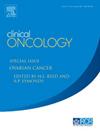Feasibility and Outcomes of Craniospinal Irradiation and Concurrent Daily Carboplatin in Children and Adults With High-risk Central Nervous System Tumours
IF 3
3区 医学
Q2 ONCOLOGY
引用次数: 0
Abstract
Aims
High-risk medulloblastoma, pineoblastoma, and other embryonal central nervous system (CNS) tumours are associated with a poor prognosis. Children's Oncology Group trial CCG-99701 demonstrated concomitant daily carboplatin during radiotherapy, followed by adjuvant chemotherapy, to be a promising strategy for treating these malignancies in children. In this case series, we describe treatment feasibility, toxicities, and outcomes for children and adults from a heterogeneous real-world population, treated with this regimen for high-risk CNS tumours.
Materials and methods
Data from clinical records were collected on surgery, radiotherapy, chemotherapy, acute toxicities, supportive treatment, and survival for all patients treated with the regimen between January 2012 and June 2018.
Results
Twenty-seven patients (13 children and 14 adults) received chemoradiotherapy. Seven patients (26%) were rested for one or more radiotherapy fractions due to medical or anaesthetic issues, and 4 patients (15%) had an extended overall treatment time. Grade 4 haematological toxicity was common, but no grade 4 non-haematological toxicities were observed. Twenty-two patients (81%) required haematological support. Two patients discontinued adjuvant chemotherapy early due to toxicity. Two-year overall survival (OS) in paediatric and adult patients was 85% and 46%, respectively, and 5-year OS was 69% and 38%, respectively. Progression-free survival (PFS) was significantly longer in paediatric patients than in adults (median PFS not reached and 0.9 years, respectively; hazard ratio: 0.26; 95% confidence interval [CI]: 0.09 to 0.75; P = 0.01). There was no significant difference in OS between paediatric and adult patients (median OS not reached and 1.3 years, respectively; hazard ratio: 0.43; 95% CI: 0.14 to 1.29; P = 0.12).
Conclusion
The treatment regimen was feasible for paediatric and adult patients but was associated with significant toxicity. The survival outcomes in paediatric patients were favourable, consistent with published data. Due to the close clinical supervision required, this regimen should ideally be delivered in centres with experience in managing paediatric or teenage and young adult high-risk CNS tumours.
儿童和成人高危中枢神经系统肿瘤患者颅脊髓照射和同时每日卡铂治疗的可行性和结果
目的:高危髓母细胞瘤、松果体母细胞瘤和其他胚胎性中枢神经系统(CNS)肿瘤预后不良。儿童肿瘤组试验CCG-99701表明,在放疗期间每日服用卡铂,然后辅助化疗,是治疗这些儿童恶性肿瘤的一种有希望的策略。在这个病例系列中,我们描述了来自异质现实世界人群的儿童和成人的治疗可行性、毒性和结果,用这种方案治疗高危中枢神经系统肿瘤。材料和方法收集2012年1月至2018年6月期间所有接受该方案治疗的患者的手术、放疗、化疗、急性毒性、支持治疗和生存的临床记录数据。结果27例患者接受放化疗,其中儿童13例,成人14例。7例(26%)患者因医疗或麻醉问题而休息一次或多次放疗,4例(15%)患者延长了整体治疗时间。4级血液学毒性很常见,但未观察到4级非血液学毒性。22例(81%)患者需要血液学支持。2例患者因毒性而早期停止辅助化疗。儿童和成人患者的两年总生存率(OS)分别为85%和46%,5年总生存率(OS)分别为69%和38%。儿童患者的无进展生存期(PFS)明显长于成人(中位PFS未达到和0.9年;风险比:0.26;95%置信区间[CI]: 0.09 ~ 0.75;P = 0.01)。儿童和成人患者的生存期无显著差异(中位生存期分别为未达到和1.3年;风险比:0.43;95% CI: 0.14 ~ 1.29;P = 0.12)。结论该治疗方案适用于儿童和成人患者,但存在明显的毒性。儿科患者的生存结果是有利的,与已发表的数据一致。由于需要密切的临床监督,理想情况下,该方案应在具有治疗儿科或青少年和年轻成人高危中枢神经系统肿瘤经验的中心实施。
本文章由计算机程序翻译,如有差异,请以英文原文为准。
求助全文
约1分钟内获得全文
求助全文
来源期刊

Clinical oncology
医学-肿瘤学
CiteScore
5.20
自引率
8.80%
发文量
332
审稿时长
40 days
期刊介绍:
Clinical Oncology is an International cancer journal covering all aspects of the clinical management of cancer patients, reflecting a multidisciplinary approach to therapy. Papers, editorials and reviews are published on all types of malignant disease embracing, pathology, diagnosis and treatment, including radiotherapy, chemotherapy, surgery, combined modality treatment and palliative care. Research and review papers covering epidemiology, radiobiology, radiation physics, tumour biology, and immunology are also published, together with letters to the editor, case reports and book reviews.
 求助内容:
求助内容: 应助结果提醒方式:
应助结果提醒方式:


